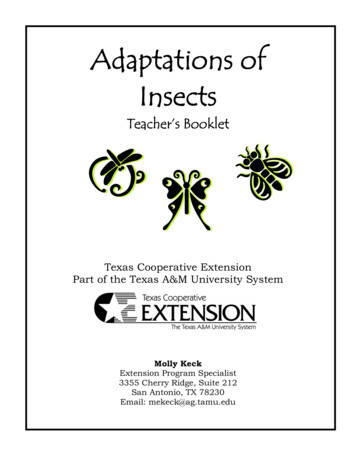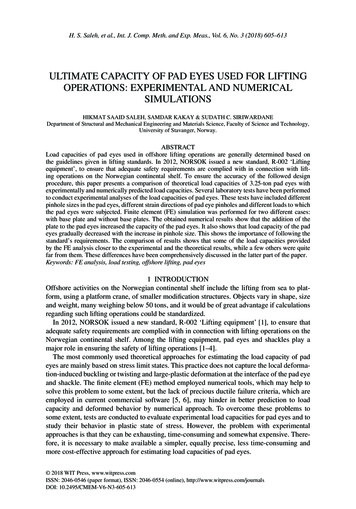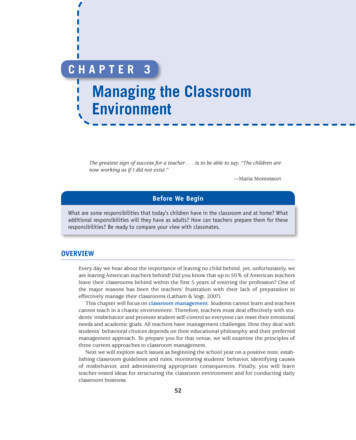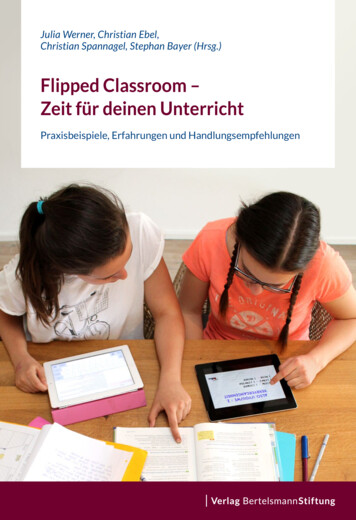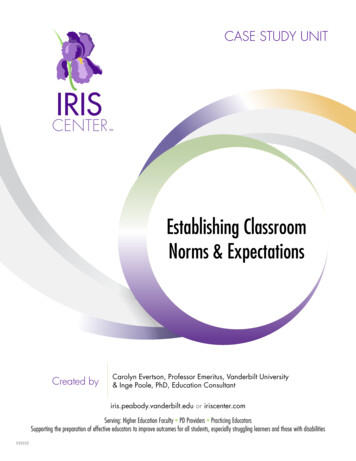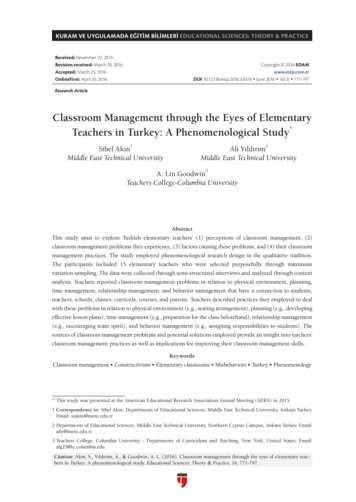
Transcription
KURAM VE UYGULAMADA EĞİTİM BİLİMLERİ EDUCATIONAL SCIENCES: THEORY & PRACTICEReceived: November 22, 2015Revision received: March 20, 2016Accepted: March 25, 2016OnlineFirst: April 20, 2016Copyright 2016 EDAMwww.estp.com.trDOI 10.12738/estp.2016.3.0376 June 2016 16(3) 771-797Research ArticleClassroom Management through the Eyes of ElementaryTeachers in Turkey: A Phenomenological Study*1Sibel AkınMiddle East Technical University2Ali YıldırımMiddle East Technical University3A. Lin GoodwinTeachers College-Columbia UniversityAbstractThis study aims to explore Turkish elementary teachers’ (1) perceptions of classroom management, (2)classroom management problems they experience, (3) factors causing these problems, and (4) their classroommanagement practices. The study employed phenomenological research design in the qualitative tradition.The participants included 15 elementary teachers who were selected purposefully through maximumvariation sampling. The data were collected through semi-structured interviews and analyzed through contentanalysis. Teachers reported classroom management problems in relation to physical environment, planning,time management, relationship management, and behavior management that have a connection to students,teachers, schools, classes, curricula, courses, and parents. Teachers described practices they employed to dealwith these problems in relation to physical environment (e.g., seating arrangement), planning (e.g., developingeffective lesson plans), time management (e.g., preparation for the class beforehand), relationship management(e.g., encouraging team spirit), and behavior management (e.g., assigning responsibilities to students). Thesources of classroom management problems and potential solutions employed provide an insight into teachers’classroom management practices as well as implications for improving their classroom management skills.KeywordsClassroom management Constructivism Elementary classrooms Misbehaviors Turkey Phenomenology* This study was presented at the American Educational Research Association Annual Meeting (AERA) in 2015.1 Correspondence to: Sibel Akın, Departments of Educational Sciences, Middle East Technical University, Ankara Turkey.Email: siakin@metu.edu.tr2 Departments of Educational Sciences, Middle East Technical University, Northern Cyprus Campus, Ankara Turkey. Email:aliy@metu.edu.tr3 Teachers College, Columbia University - Departments of Curriculum and Teaching, New York, United States: Email:alg25@tc.columbia.eduCitation: Akın, S., Yıldırım, A., & Goodwin, A. L. (2016). Classroom management through the eyes of elementary teachers in Turkey: A phenomenological study. Educational Sciences: Theory & Practice, 16, 771-797.
EDUCATIONAL SCIENCES: THEORY & PRACTICESince classrooms are complex social and cultural settings with multiple eventsoccurring simultaneously (Poole & Evertson, 2013), classroom management isconsidered to be key to effective teaching. That is, teaching is a complex endeavor whichrequires teachers not only be effective in delivering the instruction but also maintainingthe order (Rosas & West, 2009). Research has supported the importance of classroommanagement for effective teaching and studies demonstrate that more effective teachersgenerally have better organized classrooms and fewer behavior problems (Evertson,1985, 1989). Effective classroom management has been characterized as the process ofestablishing, maintaining, and restoring the classroom environment in an effective wayfor teaching and learning (Brophy, 1986). It refers to all actions taken by the teacherto create an effective classroom atmosphere where students could be highly engaged inlessons (Doyle, 1986; Romi, Lewis, & Roache, 2013). This is, in return, expected tostrongly influence the academic achievement of learners (Marzano & Marzano, 2003;Wang, Heartel, & Walberg, 1993) because it is widely documented that the actual timestudents spend on meaningful tasks is fundamental to their learning gains (Kunter,Baumert, & Köller, 2007). However, classroom management has been ranked as one ofthe major problems that teachers face (Rosas & West, 2009; Wubbels, 2011) because inregular classrooms, the available time is spent not only on learning activities, but also onnon-curricular activities, organizational issues, or disciplinary problems (Kunter et al.,2007). As poor classroom management interferes with teaching and learning practices, iteventually becomes a major cause for teacher stress (Friedman, 2006), teacher burnoutand job dissatisfaction (Garrahy, Cothran, & Kulinna, 2005; Ingersoll, 2001) and results inteachers transferring to other schools or leaving the profession (Ingersoll & Smith, 2003;Rosas & West, 2009). It is also not surprising that classroom management is especiallya high priority concern for beginning teachers (Doyle, 1975; Wubbels, 2011) given thestrong possibility that failure to master the essential management skills causes discourageand disappointing experiences with students in class (Doyle, 1975).Especially in today’s world, the variety of stimuli in learning environments, thereality of social change leading to a diversity in the interests and needs of learners, andthe heterogeneity in the background of the students, such as ethnicity, gender, ability,health, nationality, geographic region, social class, and age (Cushner, McClelland, &Safford, 2009; Gay & Howard, 2000) exacerbate the fact that classroom managementhas been a more serious concern for teachers than it has ever been before (Emmer &Stough, 2001; Milner & Tenore, 2010). Considering the fact that goals of educationon the part of students have changed dramatically in the current era (Evertson & Neal,2006) and cognitive theories have been more influential on education, educationalsettings have stronger orientations towards student-centered learning environmentsover the past years. As a result, teachers are required to address the needs of theirstudents who demonstrate an increasing demographic variety. Therefore, to maximizestudents’ development by matching the school culture with student characteristics,772
Akın, Yıldırım, Goodwin / Classroom Management through the Eyes of Elementary Teachers in Turkey:.teachers are expected to practice culturally responsive pedagogy. According toLadson-Billings (1992), culturally responsive pedagogy is a term which is used todescribe the kind of teaching in which student culture is used as the foundation forenabling students to understand themselves and others. This mainly implies thatteachers should acknowledge the contexts, be responsive to the needs and interestsof students, be responsible for the academic progress of all students, and integratethe elements of students’ culture in their teaching. From a theoretical viewpoint,culturally responsive pedagogy has its foundations in social constructivism whichencourages learner-centered education with a serious emphasis on responding todiverse characteristics and needs of all students as reality is constructed within acontext through the terms, such as language, by which people perceive the reality(Au, 1998; Cummins, 1986; Schwandt, 1994). Consequently, empowerment ofstudents with diverse backgrounds may lead to all students’ successful participationin learning activities where teacher is a mediator.Despite the serious call for culturally responsive pedagogy, research on multiculturaleducation has tended to neglect the classroom management aspect (Weinstein,Tomlinson-Clarke, & Curran, 2004). However, the context of classroom managementpractices has drawn attention as the background and settings may account for whatstudents and teachers bring to the instructional process (Gay, 2002). The context,which might vary according to instructional goals, subject matter, grade, age, useof technology, socio-economic status of students, emotional and behavior disordersof students and so forth, has strong implications for classroom management, as well(Emmer & Stough, 2001). Ultimately, bringing contextual factors to a conscious levelis more likely to result in implementing equity initiatives in classroom, promotingfreedom and justice for everyone, and making learning opportunities possible for allstudents (Gay, 2002; Weinstein, Curran, & Tomlinson- Clarke, 2003).Taking into consideration the close connection between the context and classroommanagement practices, the investigation of the way teachers understand and implementclassroom management processes requires a close look into physical, cultural, andpsychological aspects of classrooms. Turkish education has recently gone througha shift from behavioral to cognitive approaches in the curriculum and instruction.Despite this reform, such transformation in schooling practices has been challengingfor teachers since Turkish education system still heavily depends on standardizedtesting. Besides, the social context of schools particularly with prevalence ofunsupportive and unstandardized infrastructure, strict rules, and discipline do notleave much room for constructivist practices. Hence, it has been difficult for teachersto quit their behaviorism-oriented classroom practices and to switch to constructivistprocesses in classrooms.773
EDUCATIONAL SCIENCES: THEORY & PRACTICEAlong with the shift in the educational approaches, teachers are expected toadopt, in particular, a student-centered approach to classroom management (Çandar& Şahin, 2013). That is, as the schools are having an increasingly diverse studentpopulation, teachers are encountering with a wider range of student behaviors andthey are expected to respond more effectively to the misbehaviors (Mundschenk,Miner, & Nastally, 2011). However, classroom management, indeed, has been oneof the most debated issues in Turkish education system and it is mostly associatedwith discipline which has a lot to do with seeing the teacher as the authority of theclass (Akar & Yildirim, 2009). For instance, in Saban’s (2004) study, it was seen thatnearly two-thirds of the prospective elementary teachers perceived the role of teacheras the source of knowledge, one who transmits the knowledge, modifies students’behavior and one-third of them perceived their role as a guide in the learning process.Similarly, Akar, Tantekin-Erden, Tor, and Şahin (2010) found out that K-8 teachers hada tendency to practice traditional classroom management. On the other hand, in theirstudy, Akar and Yildirim (2009) observed that teacher candidates underwent througha conceptual change in their metaphorical images about classroom managementafter experiencing a constructivist learning environment in a classroom managementcourse. In their study, they found out that teacher candidates’ descriptions of themetaphorical images about classroom management portrayed more a leading type ofclassroom management (e.g. orchestra conductor, football match, coach, theatre play,leader, boss, shepherd, and lion). This may imply that constructivist expectations andpractices may create a change in conceptions of classroom management. Similarly,a study by Örücü (2012), conducted after the constructivist reform has taken placein Turkish education system, demonstrated that orchestra conducting, familymanagement, ship, and factory management were the metaphors used by elementaryteachers to reflect the idea of classroom management.The classroom management problems most frequently experienced in Turkishschools have been reported to be talking out of turn, making noise, disturbingothers, engaging in irrelevant activities, hyperactivity, making fun of other children,inattentiveness, attention deficiency, lack of motivation, chatting, daydreaming andnot following instructions, complaining about classmates, nicknaming, and misusingthe materials (Akkok, Askar, & Sucuoglu, 1995; Altınel, 2006; Atici, 2007; Atici& Merry, 2001; Cabaroğlu, 2012; Cabaroğlu & Altınel, 2010; Demir, 2009; Güleç& Balçik, 2011; Türnüklü & Galton, 2001). The sources of misbehaviors might beattributed to families, teachers, students’ characteristics, and environmental factors(Atici, 2007; Cabaroğlu, 2012; Güleç & Balçik, 2011). With regards to classroommanagement, Akar et al. (2010) reported that K-8 teachers in Turkey mainly considerfive themes, namely, the physical setting, planning the first days and motivation, rulesand routines, coping with misbehaviors, and establishing teacher-parent cooperation.Moreover, individual talk about reason, talking with the disruptive student after the774
Akın, Yıldırım, Goodwin / Classroom Management through the Eyes of Elementary Teachers in Turkey:.class, changing the group of the student, verbal and non-verbal warning, intonation,eye contact, hand clapping, monitoring, positive reinforcement, getting help from theschool administrators or the psychological counselor, purposeful ignorance, assigningresponsibilities, punishment, sending out, use of humour, providing instructions,reminding the class rules, asking questions, and reprimanding have been some of theclassroom management practices that teachers mostly employ in schools in Turkey(Altınel, 2006; Atıcı, 2001; Atici, 2007; Cabaroğlu, 2012; Cabaroğlu & Altınel, 2010;Çakmak, Kayabaşı, & Ercan, 2008; Demir, 2009; Gokmenoglu, Eret, & Kiraz, 2010;Güleç & Alkış, 2004; Lozano & Kizilaslan, 2013; Sarıtaş, 2006).These research results show that while some of the practices employed by theteachers are more teacher-centered and having roots in behaviorism, teachers tendto integrate student-centered approach into their classroom management practicesas well. On the other hand, it has been reported that even if it has been almost adecade since after the constructivist reform, the learning environment in theelementary classrooms is not yet truly aligned with constructivism (Baş, 2012). Intheir study, Çandar and Şahin (2013) also conclude that elementary teachers need tobe more competent at classroom management if they are to establish a constructivistlearning environment. Considering the long history of behaviorist orientation in theTurkish education system and the recent changes in the school curriculum towardconstructivist teaching and learning process, it might be important to understand howteachers are shaping their classroom management practices and what they think abouttheir effectiveness. In addition, the recent change in the school structure from 8 3 to4 4 4 model resulting in the schooling of younger children in primary schools mightalso have some influence on teachers’ classroom management behaviors. In theirstudy, Cerit, Akgün, Yıldız and Soysal (2014) concluded that schooling of youngerchildren was the most outstanding problem of the new reform. Similarly, in thestudy conducted by Boz and Yıldırım (2014), 55% of the teachers reported that theyexperienced classroom management difficulties with the 60-65-month-old studentsin the class and that the age of those young students was the primary source of mostproblems leading to the classroom management difficulties. In addition, the 3-monthadaptation period, in which teachers are expected to do preparation studies instead ofimplementing the formal curriculum, might have an impact on elementary teachers’classroom management experiences as they, thereby, encounter more difficulties withimplementing the curriculum in the remaining school year especially with the effectsof lack of revised curricula and textbooks (Boz & Yıldırım, 2014).The literature does not provide us with a good understanding of teachers’experiences of classroom management issues since studies investigating teachers’perceptions of classroom management practices based on these changes andcontextual challenges are only a few. In addition to this, a review study (Erdogan775
EDUCATIONAL SCIENCES: THEORY & PRACTICE& Kurt, 2015) on classroom management show that most studies focus on teacherprofile and behaviors (40.7%) and teachers’ efficiency (24%) while they are followedby classroom discipline problems (20.3%) and classroom management strategies(14.8%), which predominantly employ quantitative research designs. This qualitativestudy aims to investigate teachers’ perceptions of classroom management from thestandpoint of recent changes in the educational system as well as the contextualchallenges teachers face in their classrooms, distinctly in a broader structure wheremetaphors, problems, factors, and practices are studied together. More specifically,the study seeks to answer the following research questions:1. What are the perceptions of elementary teachers about classroom management?2. What are the classroom management problems that elementary teachersencounter?3. What are the underlying reasons of the classroom management problems fromthe perspectives of elementary teachers?4. What are the practices of elementary teachers to deal with the classroommanagement problems?MethodDesignThis study is designed as a phenomenological qualitative inquiry. The term“qualitative” implies an emphasis on the meanings and processes that are notinvestigated through experiments or measured in terms of quantity, amount, orfrequency (Denzin & Lincoln, 2000). Concentrating on the deeper meaningsindividuals assigned to their lived experiences (Creswell, 2007; Marshall & Rossman,2006) toward classroom management, the qualitative phenomenological design inthis study mainly relies on rich and detailed descriptions by participants’ own words(Marshall & Rossman, 2006). Phenomenology primarily rests on the assumption thathuman beings have some commonality or essence as they experience a phenomenon;thereby, phenomenologists seek to describe this shared structure (Creswell, 2007;Fraenkel & Wallen, 2006; Marshall & Rossman, 2006).ParticipantsIn this qualitative study, the participants of the study were selected purposefully throughmaximum variation sampling (Patton, 1990). This allowed including a wide range ofvariation on certain dimensions (Patton, 1990) in participating teachers such as teachingdifferent grade levels and the university graduated, which might influence teachers’776
Akın, Yıldırım, Goodwin / Classroom Management through the Eyes of Elementary Teachers in Turkey:.classroom management perceptions. Although sample size is usually around 7-10 forphenomenological studies (Yıldırım & Şimşek, 2011), this study involved 15 femaleelementary teachers to ensure the data saturation as the weightier concerns regardingthe number of participants in qualitative research mainly relate to data saturation. Theparticipating teachers (Teacher-A, -B, -C, -D, -E, -F, -G, -H, -I, -J, -K, -L, -M, -N, -O)graduated from education faculties of different universities and represent different classlevels: 4 teaching 1st grade, 3 teaching 2nd grade, 3 teaching 3rd grade, and 5 teaching4th grade, holding only undergraduate degree, and working in public elementary schoolsin Ankara, Turkey. Their teaching experience ranged from 3 to 18 years. All teachershad taken a classroom management course during their initial teacher preparation. Thenumber of the students they have in their classrooms ranged from 20 to 43.Data Collection InstrumentTo gather data in the subjects’ own words and uncover the participants’ perspectiveson a phenomenon, qualitative researchers depend to a large extent on in-depthinterviewing (Bogdan & Biklen, 2007; Marshall & Rossman, 2006). The primaryadvantage of interviewing is that it focuses on the deep meanings assuming that theyguide the actions (Marshall & Rossman, 2006). Accordingly, the data were collectedthrough semi-structured, face-to-face, and in-depth interviews. This approach allowsfor the specification of the questions in advance, offers the interviewer considerableflexibility to ask for a range of topics and offers the subject a chance to shape thecontent of the interview. In addition, it allows for getting somewhat systematic andcomparable data across respondents through an interview form as well as allowingfor addressing the depths of the phenomenon (Bogdan & Biklen, 2007; Patton, 1990).The interview schedule in this study was developed by the researchers on the basis ofthe review of related literature and the research questions of the study. It was developedin Turkish and consisted of open-ended questions to elicit in-depth information forthe purpose of the study (e.g., When you consider your experience as a teacher withstudents, what comes to your mind in relation to “classroom management” concept?,What kind of a classroom management system do you have as a teacher?).Having taken the opinions of three experts to prevent ambiguity and to establishconnection between the purpose of research and the questions in the interview, theinstrument was revised on the basis of given feedback. Then, it was piloted with threeelementary teachers to assure the clarity, relevance, and effectiveness of the questionsas well as to assess the flow of the questions and timing.Data AnalysisEach interview took nearly 30 to 45 minutes and was audio-recorded. In qualitativestudies, data analysis involves breaking the data into manageable parts, searching for777
EDUCATIONAL SCIENCES: THEORY & PRACTICEpatterns, and synthesizing them (Bogdan & Biklen, 2007). Correspondingly, contentanalysis was used to analyze the data. To this end, all the audio-recorded interviewswere first transcribed verbatim by using a computer-based word processing program,and then with the help of the initial concepts from the relevant literature and theresearch questions as guidelines, each transcription was coded to derive relevantthemes. As the initial categories were derived and themes were shaped around theemerging codes, they were subjected to refinement until the write-up stage. Finally,alongside the reporting of the findings and interpretations, all the themes related to theresearch questions were described and exemplified in detail through quotations whichwere translated from Turkish to English. To ensure that all the meanings and nuancesare well-reflected in the translations, an expert was asked to provide her opinions onthe translated quotations by comparing them with the original expressions.TrustworthinessTo ensure rigor in qualitative research, trustworthiness can be assessed through thecriteria of credibility, transferability, dependability, and confirmability, all of whichcan be satisfied through several strategies (Marshall & Rossman, 2006). In orderto address trustworthiness in this study, firstly, credibility was assured through thefollowing strategies: consulting experts after developing the interview schedules andmaking necessary revisions, piloting the interview schedules before the actual datacollection, in-depth and thorough data collection with the use of open-ended interviewquestions, member checks through checking both the data and the interpretationswith the selected participants, prolonged engagement with data through spendingsufficient time for each interview and also having an iterative data coding process,persistent observation by a thorough data collection, detailed transcriptions, andresearchers’ notes, and finally peer debriefing by having conceptual discussions withanother researcher who has expertise in qualitative research. Second, transferabilitywas addressed through purposive selection of the participants with the use ofmaximum variation sampling and also through thick description by describing thecontext, relevant characteristics of the participants, data collection, analysis, andresults. Finally, for dependability and confirmability, audit trail was employed tocheck the consistency and objectivity of the results through the constant feedbackprovided by a qualitative researcher in the research process and at the end.ResultsPositive and Negative Connotations about Classroom ManagementThe results revealed that teachers had both positive and negative associationswith classroom management. On the positive side, teachers perceived classroom778
Akın, Yıldırım, Goodwin / Classroom Management through the Eyes of Elementary Teachers in Turkey:.management not as a way of strict discipline, but as assigning responsibilities tostudents, developing a sense of belonging on the part of the students, establishingrules together, enabling students to enjoy the school and the class, having a two-waycommunication in the class, recognizing students’ needs and interests and respectingtheir individual differences, and also encouraging students to respect each other. Toillustrate, Teacher A said that:I don’t necessarily think of discipline when I think about classroom management. Myclassroom management is mainly based on assigning responsibilities to students. Eachstudent is a unique individual and it is more important for me that s/he feels at home in theclass, joins the process of establishing the rules, etc. I have 25 students and each of themhas their own roles in the class. I always do so.On the negative side, classroom management was perceived to be directlyconnected to the problems and also the skills for solving those problems, as TeacherB expressed that:When someone mentions classroom management, it makes me to think about the problems,the possible problems that might occur in the classroom. What kind of problems I mayhave Problems and the ability of problem solving The problems are not necessarilyonly about the students, it could be any problem Metaphorical ImagesTeachers’ perceptions and experiences revealed different metaphors in relation tonot only classroom management itself but also their own and their students’ positionsin the context of classroom management.Most teachers resembled classroom management to an “orchestra,” particularlyreflecting the idea of acting in harmony. From her own words, Teacher A asserted that:It resembles to an orchestra Yes, the teacher is coordinating and leading the class.Certainly, there are a lot of different voices in the class. In my opinion, classroommanagement is the ability of putting these voices in harmony.A number of teachers, in a similar manner, perceived the classroom managementas a “game” given that it allows for freedom and happiness as well as it requiresthe establishment of rules. Some teachers thought that classroom management issimilar to “music” in the sense of being a tool to create a positive atmosphere. Afew teachers perceived the classroom management as a way of “self-expression andcommunication.” Finally, one teacher resembled classroom management to the actof “reflecting,” pointing out that whatever happening in the classroom is two-way:reflected from teacher to students and from students to teacher.779
EDUCATIONAL SCIENCES: THEORY & PRACTICEMost teachers viewed the teacher in the context of classroom management as the“coordinator of the orchestra or maestro” in terms of assigning responsibilities to students,coordinating them, and being the leader of the group who creates the harmony. Othermetaphors associated with the teacher in the context of classroom management were the“motion-sensitive camera” in terms of immediately responding to every child, the “mirror”in terms of being a primary means for the mirror images (students), and the “Earth” interms of observing all different stars (students). To illustrate, Teacher E said that:Myself, as a teacher You know, there are some motion-sensitive cameras which movearound according to the surrounding motions Just like a motion-sensitive camera, I haveto move around to be aware of all students and to respond them quickly.Teachers metaphorically associated the students mostly with “stage actors,” “theatreplayers,” “ant swarm,” “instruments for an orchestra,” “songs,” “mirror reflection ofteachers,” “songs,” “stars” or “snowflakes,” and “artists playing different instruments.”within the context of classroom management. The common point reflected in mostof these metaphors was students’ having unique individual characteristics, differentresponsibilities or roles in the class, as Teacher H and Teacher K clearly expressed that: To me, they all look like different theatre players. Each of them is different, eachof them has her/his responsibilities. All of them have their own roles in the class, they areall different individuals. (Teacher H)They are just similar to the stars or snowflakes. None of the stars look like each other,neither do students. They are all different from each other. As a result, my approach toevery single one is also different. They have their own individual characteristics, so youcannot expect that the same approach fits to everyone. (Teacher K)Perceptions of Elementary Teachers about Classroom Management ProblemsClassroom management problems teachers experienced were mainly related toplanning, time-management, relations with students, and behavior management.Planning-related handicaps. Regarding the first category, planning relatedhandicaps mostly centered on the curriculum. Teachers mentioned that they were notable to catch up with the curriculum due to the insufficient course hour. They alsorelated their concerns to the heavy number of objectives in curricula, the inflexibilityof the centralized curriculum to different settings, and yearly unit plans’ taking toomuch time. For example; Teacher J mentioned that:The curricula are not developed by considering those different regions which have alldifferent characteristics. As a result, the curricula that we have been implementing aremostly applicable to the urban areas or big cities but we definitely need to modify them780
Akın, Yıldırım, Goodwin / Classroom Management through the Eyes of Elementary Teachers in Turkey:.according to our settings because what they offer in the curricula are not always applicableto our settings or to the opportunities that we have. I used to work in various settings beforeand this is something that I can say for sure.Time management-related handicaps. Being connected to both curriculum andstudents, teache
Akın, Yıldırım, Goodwin / Classroom Management through the Eyes of Elementary Teachers in Turkey:. teachers are expected to practice culturally responsive pedagogy. According to Ladson-Billings (1992), culturally responsive pedagogy is a term which is used to describe the kind of teaching in which student culture is used as the foundation for



